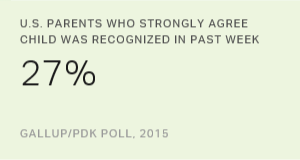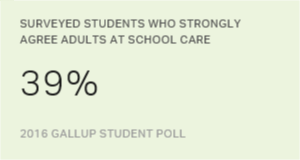A quarter (27%) of U.S. parents with children in public schools strongly agreed that their child received recognition or praise from a teacher for good schoolwork in the last seven days, according to the 47th Gallup/PDK Poll of the Public's Attitudes Toward the Public Schools. Seventeen percent of parents disagreed or strongly disagreed that their child received recognition in the last seven days.

Student perceptions about praise and recognition at school are not much better. The 2014 Gallup Student Poll, which surveyed more than 800,000 U.S. public school students, revealed that 31% of fifth- through 12th-graders who took the survey strongly agreed that they received recognition and praise for doing good schoolwork in the last seven days.
The theory of the "dipper and the bucket" posits that recognition for a job well-done creates positive emotions and builds engagement with work and school. Gallup's engagement research in education -- and across dozens of other industries -- underscores the critical nature of recognition and acknowledgement of talent to building engagement and improving performance.
Engaged students are involved with and enthusiastic about school, and their engagement with school is attributable, in part, to receiving emotional reinforcement for doing good work and using their strengths to positively contribute to the learning environment. The Gallup/PDK poll suggests many students are lacking these key engagement opportunities.
Engaging students may help drive student success. While many parents and students report adequate praise and recognition, millions of students are not receiving the kudos they need to reinforce engagement, and too few get to practice what they do best at school.
When it comes to students' opportunities to use their strengths, parents are a bit less positive than their children are. Fourteen percent of parents surveyed strongly agreed that their student has the opportunity to do what he or she does best at school -- in fact, they were somewhat more likely to say their child didn't have such opportunities (21%). About four in 10 students surveyed, however, strongly agreed that they had the opportunity to do what they do best at school.
To engage students, schools need to find creative ways to encourage great effort. They should develop a thoughtful, systematic praise and recognition program that encourages what students do well -- one that acknowledges their persistence, resilience, attention to detail, improvement, strategic thinking and unique contributions to the learning community. Parents can help by sharing with teachers how their child can be best recognized and by providing insight into where their child excels.
For example, one elementary school in Nebraska is intentional about communicating with parents not only when there is a cause for concern, but also when their child has been successful or contributed meaningfully to the learning culture. Teachers send postcards in the mail to inform parents when their child has done good work. The principal makes phone calls home when a child achieves a goal or earns recognition. They also employ a "caught being good" recognition program that honors kids when they do great things for others, even when they are not prompted to or asked. So put a drop in a student's bucket today. The ripples from that drop may extend farther than you realize.
